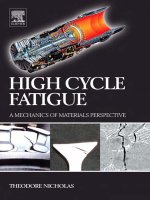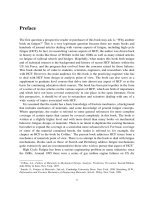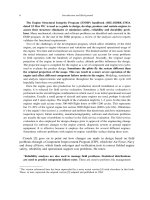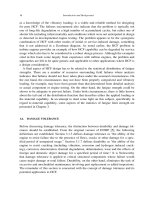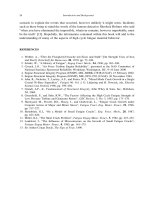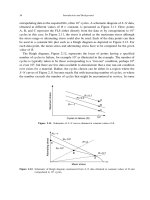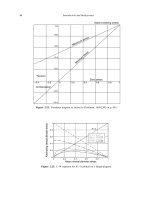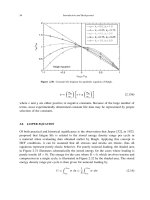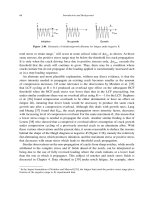Ebook Structure mechanics of woven fabrics: Part 2
Bạn đang xem bản rút gọn của tài liệu. Xem và tải ngay bản đầy đủ của tài liệu tại đây (494.43 KB, 20 trang )
<span class='text_page_counter'>(1)</span><div class='page_container' data-page=1>
123
<b>5</b>
The bending properties of woven fabrics
<b>5.1</b>
<b>General bending behaviour of woven fabrics</b>
5.1.1
Introduction
The bending properties of fabrics govern many aspects of fabric performance,
such as hand and drape, and they are an essential part of the complex fabric
deformation analysis. Thus, the bending of woven fabrics has received
considerable attention in the literature. Computational models for solving
large-deflection elastic problems from theoretical models have been applied
to specific fabric engineering and apparel industry problems, for example,
the prediction of the robotic path for controlling the laying of fabric onto a
<i>work surface (Brown et al., 1990, Clapp and Peng, 1991).</i>
The most detailed analyses of the bending behaviour of plain-weave fabrics
<i>were given by Abbott et al. (1973), de Jong and Postle (1977), Ghosh et al.</i>
<i>(1990a,b,c), Lloyd et al. (1978) and Hu et al. (1999, 2000). Modelling the</i>
bending of a woven fabric requires knowledge of the relationship between
fabric bending rigidity, the structural features of the fabric, and the tensile/
bending properties of the constituent yarns, measured empirically or determined
through the properties of its constituent fibres and the yarn structure. It
requires a large number of parameters and is very difficult to express in a
closed form. Thus, the applicability of such models is very limited. Konopasek
(1980a) proposed a cubic-spline-interpolation technique to represent the fabric
moment–curvature relationship.
5.1.2 Moment–curvature curve of bending behaviour
</div>
<span class='text_page_counter'>(2)</span><div class='page_container' data-page=2>
fibres and the structure of the yarn. The relationships among them are highly
complex. Figure 5.1 illustrates a typical bending curve of woven fabrics.
For this curve, it is normally thought that there is a two-stage behaviour
with a hysteresis loop within low-stress deformation: (a) an initial higher
stiffness non-linear region, OA; within this region the curve shows that the
effective stiffness of the fabric decreases with increasing curvature from the
zero-motion position, as more and more of the constituent fibres are set in
motion at the contact points; (b) a close-to-linear region, AB; since all the
contact points are set in motion, the stiffness of the fabric seems to be
close-to-constant.
It should be noted that when a woven fabric is bent in the warp or weft
direction, the curvature imposed on the individual fibres in the fabric is
almost the same as the curvature imposed on the fabric as a whole. As high
curvatures meet when fabrics are wrinkled, the coercive couple or hysteresis
is affected by viscoelastic decay of stress in the fibre during the bending
<i>cycle (Postle et al., 1988). However, in applications where the fabric is</i>
subjected to low-curvature bending, such as in drapes, the frictional component
dominates the hysteresis. Thus, if the strain in the individual fibres is sufficiently
small that viscoelastic deformation within the fibres can be neglected, the
hysteresis in Fig. 5.1 is attributed to non-recoverable work done in overcoming
the frictional forces. The effect of the fibre’s viscoelasticity in this section
will not be considered because the bending of fabrics on the KES tester is
within low-stress regions.
5.1.3
Bending stiffness
The primary concern with the conventional research in fabric bending is the
bending stiffness. Bending stiffness is one of the main properties that control
A
O Curvature
B
Bending moment
</div>
<span class='text_page_counter'>(3)</span><div class='page_container' data-page=3>
fabric bending. It should be defined as the first derivative of the moment–
<i>curvature (M–</i>r<i>) curve. If the structure of the bending curve is linear, M is</i>
directly proportional to the curvature produced. Some studies have been
conducted to predict fabric bending stiffness. It has proved very difficult to
calculate bending stiffness explicitly, due to the numerous factors that affect
its value if the stiffness of the whole bending process is considered. In
reality, the bending stiffness of fabrics is usually approximated to a constant
which can be considered as steady-state-average-stiffness and the initial
non-linear region is ignored. This is a low-order approximation to the actual
non-linear bending properties present in most fabrics. Clapp and Peng (1991)
have shown that the approximation to a constant stiffness may yield inaccurate
values when calculating the fabric-buckling force in the initial buckling
<i>stage (Brown, 1998). As we can see in Fig. 5.1, the actual experimental M–</i>
r curves are non-linear, at least in the initial region in which the slope of the
<i>M–</i>r curve for small values of r is greater than that for larger values of r.
<i>Thus, the bending-stiffness, B, should be a non-linear, continuous function</i>
of curvature.
5.1.4
Relationship between bending stiffness and
bending
hysteresis
</div>
<span class='text_page_counter'>(4)</span><div class='page_container' data-page=4>
1976) thought internal friction is always present during deformation but is
independent of elastic stiffness. They all agreed that hysteresis is a measure
of internal friction.
<b>5.2</b>
<b>Modelling the bending behaviour of</b>
<b>woven fabrics</b>
5.2.1
Modelling the bending curves using non-linear
regression
The modelling of the bending (moment–curvature) curve of woven fabrics
started with the work of Peirce (1930). The theoretical modelling can be
divided into three categories: predictive modelling, descriptive modelling
and numerical modelling. The majority of the existing research work has
been in the area of predictive modelling, in which the analytical relationship
between fabric bending properties, yarn-bending behaviour and
constituent-fibre behaviour, on the assumption of a given geometrical disposition of
fibres or yarns in the fabric, is obtained. This kind of model was very difficult
to solve in a closed form and thus very difficult to apply. A review of the
<i>research in this field was carried out by Ghosh et al. (1990a,b,c). It is not</i>
intended to re-review here due to its limited relevance.
Many numerical modelling methods are used in mechanical engineering,
and they are useful for the stress–strain analysis of a structure. Konopasek
(1980) proposed the use of the cubic-spline-interpolation technique to represent
the stress–strain relationship of fabric bending. The cubic-spline-interpolation
technique is useful when the mathematical relationship between moment
and curvature is not available, but it is rather cumbersome in computation
and application. When the relationship of moment–curvature of fabric bending
is available, a non-linear regression method may be used to estimate constants
in the equation. The following introduces the descriptive model established
by Oloffson (1967). It is expected that this model can be fitted using the
non-linear regression technique.
There are examples scattered through the literature of rheological studies,
or descriptive modelling, including sliding elements that are in accordance
with Oloffson’s study, in which a simple non-viscous combination consists
<i>of a sliding element (f<sub>N</sub>) in parallel with an elastic element (E<sub>N</sub></i>) in Fig. 5.2
or a block connected by a spring to a wall.
If the initial strain is equal to zero and s≥s<i>N</i>, the conditions exist for the
displacement e<i>N</i>| as a function of the external stress s. If a series of coupled
elements of the type is considered arranged in the sequence:
</div>
<span class='text_page_counter'>(5)</span><div class='page_container' data-page=5>
s1 = s2 = s3 . . . s<i>N</i> = s [5.2]
and the total deformation can be found by summing:
e1 + e2 + e3 + . . . e<i>N</i> + . . . = e [5.3]
e= e = s 1 – s
=1
–1
=1
–1
=1
–1
S
S
S
<i>N</i>
<i>N</i>
<i>n</i> <i><sub>N</sub></i>
<i>N</i>
<i>N</i> <i>N</i>
<i>N</i>
<i>fN</i>
<i>N</i>
<i>E</i> <i>E</i> [5.4]
If a continuous model considered by changing the step function
s<i>f 1</i> < s<i>f 2</i>s<i>f 3</i> < . . . < s<i>f N</i> < . . . [5.5]
corresponding to finite elements of Fig. 5.2 into a continuous function s
<i>which increase with F (differential elements), then a continuous function for</i>
<i>EN</i> can we expressed as a function of s:
1
= d
<i>EN</i> <i>k</i>
<i>m</i>
s s [5.6]
where the infinitesimal range ds is introduced and b is the curvature of the
fabric. The equation can thus be obtained:
e = ( – s s ) = s ( – s s j s) ( ) ds
=1
–1
0
S
<i>N</i>
<i>N</i>
<i>fN</i>
<i>N</i> <i>f</i> <i>f</i> <i>f</i>
<i>E</i>
Ú
[5.7]j s( <i>f</i>) = s<i>f</i>
<i>m</i>
<i>k</i> [5.8]
and
e = s ( – s s s s) d = s
( + 1) ( + 2)
0
+2
<i>k</i> <i>k</i>
<i>m</i> <i>m</i>
<i>f</i> <i>m</i> <i>m</i>
Ú
[5.9]<i>where m is the conditional coefficient.</i>
<i>For an assembly of identical or nearly identical elements m = 0, hence a</i>
stress–strain relationship of the form:
e<i> = A</i>s2 [5.10]
or
s<i> = B</i>e
1
2 <sub>[5.11]</sub>
Frictional element
Elastic element
</div>
<span class='text_page_counter'>(6)</span><div class='page_container' data-page=6>
<i>where A and B are two arbitrary constants. Equation (5.11) has been used in</i>
several cases for bending and shear initial behaviour. From the derivation
conditions, this equation could be valid for the whole range of the deformation.
But in practice, we can see that only the initial part was thought to obey this
<i>law. The principal range of m for fabric bending was reported to be</i>
<i>– 0.1 > m > – 0.9.</i>
In conventional studies, the Oloffson’s model has only been applied when
<i>m = 0 and been used in the initial region of the moment–curvature curve; the</i>
latter stage has been considered as a linear relationship and even independent
of the frictional element. The present work makes an attempt to modify
equation 5.11 into a two-parameter function and to extend it to fit to the
whole curve of experimental results using a non-linear regression method.
The modified function including two constants a and b is as follows:
<i>M = </i>arb [5.12]
<i>where M is the bending moment and </i>r the curvature.
5.2.2 Bending stiffness
Considering bending stiffness as a constant, the bending curve of fabrics can
<i>be described using equation 5.12. If the B–K (bending stiffness, B, versus</i>
<i>curvature, K) curve is defined as the first derivative of the M–K curve,</i>
<i>B = </i>abr(b–1) [5.13]
the simulated bending stiffness now is a continuous, non-linear function of
the curvature.
5.2.3 Estimation of two constants
Similar to the methods in Chapter 4, there are several ways to estimate the
two constants a and b, but the most reliable one should be the non-linear
regression method. The second choice may be the application of a general
<i>least squares method using more than two points. Suppose there are n sets of</i>
data from a bending curve of a woven fabric (r1<i>, M</i>1), (r2<i>, M</i>2), . . . , (r<i>n, Mn</i>),
then we have:
<i>Mi</i> = ar<i>i</i>b [5.14]
So the sum of the squares of deviation from the true line is
<i>S</i> <i>M</i>
<i>i</i>
<i>n</i>
<i>i</i> <i>i</i>
= ( – )
=1
2
S
arb <sub>[5.15]</sub></div>
<span class='text_page_counter'>(7)</span><div class='page_container' data-page=7>
a r
r a
r
r
b
b
b
b
= =1 , =
–1
=1
=1
=1
S
S
S
S
<i>i</i>
<i>n</i>
<i>i</i> <i>i</i>
<i>i</i>
<i>n</i>
<i>i</i>
<i>i</i>
<i>n</i>
<i>i</i> <i>i</i>
<i>i</i>
<i>n</i>
<i>i</i>
<i>M</i> <i>M</i>
[5.16]
<b>5.3</b>
<b>Modelling the bending properties of woven</b>
<b>fabrics using viscoelasticity</b>
5.3.1
Introduction
The bending performance of fabrics is characterised through parameters
such as bending rigidity and hysteresis. However, the problem of how to
separate the viscoelastic and frictional components in hysteresis remains
unsolved. A detailed investigation of the bending of woven fabrics that
determines the frictional couple through the cyclic bending curve of the
fabric is needed. Hence, a theoretical model composed of a standard-solid
model in parallel with a sliding element is proposed. The bending properties
of woven fabrics are quantitatively studied.
</div>
<span class='text_page_counter'>(8)</span><div class='page_container' data-page=8>
5.3.2
The linear viscoelasticity theory in the modelling
of bending behaviour
Deformation, stress relaxation and subsequent recovery of fabrics can be
studied quantitatively using the rheological model of linear viscoelasticity.
Linear viscoelasticity is applicable for many viscoelastic materials when
<i>they are deformed to low strain (Postle et al., 1988). Modelling the viscoelastic</i>
behaviour of materials may involve using simple multiple-element models
or generalised integrated forms.
In order to simplify the calculation, the fibre is assumed to be linearly
viscoelastic and its bending behaviour can be described by the standard solid
model. The fabric is considered to be a viscoelastic sheet with internal frictional
constraint. Its bending behaviour can be described by a three-element linear
viscoelastic model in parallel with a frictional element, as shown in Fig. 5.2.
The model is governed by the following equation (Chapman, 1974a):
<i>M k</i>( ) = <i>M</i>v( ) + <i>k</i> <i>k k</i><b>˙</b>/| | <b>˙</b> ¥<i>M</i>f [5.17]
<i>In equation (5.17), M(k) is the bending moment of the fabric, k is the curvature</i>
<i>of the fabric at time t, M</i>f<i> is the frictional constraint and m</i>v is the viscoelastic
<b>bending moment of the fabric. ˙</b><i>k</i> is the rate of change of curvature (cm/s).
<b>The factor ˙</b><i>k k</i>/| | is the sign of the curvature change, which means that any<b>˙</b>
<i>curvature change of the fabric is opposed by the frictional constraint M</i><sub>f</sub>. The
frictional constraint interacts with the viscoelastic behaviour of single fibres
to impose a limit on the recovery a fabric may eventually attain.
Frictional constraint restricts free movement of the fibres in fabric during
bending. It is supposed that the fabric in bending acts like a linear spring in
parallel with a frictional element and the frictional constraint is assumed to
<i>be a constant M</i>0 (Grosberg, 1966; Oloffson, 1967).. The couple of the frictional
sliding element is termed the ‘coercive couple’. The coercive couple for
fabrics in bending is half the distance between the cut-offs on the vertical or
moment axis of the cyclic bending curve.
The intercept has been interpreted as being entirely due to the frictional
<i>moment and equal to 2M</i>0 in the past (Grosberg, 1966). However, the frictional
</div>
<span class='text_page_counter'>(9)</span><div class='page_container' data-page=9>
If a fabric is bent at a constant rate of change of curvature r, the viscoelastic
bending moment of the fabric of unit length can be expressed as
<i>M</i> <i>t</i> <i>B</i>
<i>t</i>
v
0
( ) = r
Ú
( ) dt t [5.18]<i>where B(</i>t) is relaxation modulus of the fabric. For a standard solid model,
<i>B(</i>t) is given by
<i>B</i> <i>E</i> <i>E E</i>
<i>E</i> <i>E</i>
<i>t T</i> <i>t T</i>
( ) = e +
+ (1 – e )
1 – /
1 2
1 2
– /
t [5.19]
<i>where the constant T = </i>h<i>/(E</i>1<i> + E</i>2<i>) is the relaxation time of the model, E</i>1 and
<i>E</i><sub>2</sub> are elasticity moduli of the springs, h is the viscosity coefficient of the
damper. Substituting equation (5.19) into equation (5.18), the viscoelastic
bending moment of the fabric can be written as follows:
<i>M</i> <i>t</i> <i>E E</i>
<i>E</i> <i>E</i> <i>t</i>
<i>E</i>
<i>E</i> <i>E</i>
<i>t T</i>
v
1 2
1 2
1
2
1 2 2
– /
( ) =
+ + r <sub>(</sub> <sub>+ </sub> <sub>)</sub> rh(1 – e ) [5.20]
<i>= at + b(1 – e–t/T</i>)
In equation (5.20),
<i>a</i> <i>E E</i>
<i>E</i> <i>E</i> <i>b</i>
<i>E</i>
<i>E</i> <i>E</i>
=
+ , = ( + )
1 2
1 2
1
2
1 2 2
r rh
<i>When the fabric is cycled between curvature k* and – k*, a typical hysteresis</i>
curve for bending deformation is as shown in Fig. 5.4. The cyclic bending
curve can be separated into regions where alternate positive and negative
rates of change of curvature are inserted. By applying equation (5.20) the
complete bending hysteresis cycle due to the viscoelasticity of the sample
can be calculated. Using the Boltzman superposition principle to add the
effects caused by the component strain rate for each portion of the hysteresis
curve of the viscoelastic component, we can calculate the moment at points
1, 2, 3 and 4 in Fig. 5.4. For bending at a constant rate of r<i> and limiting</i>
<i>curvature k*, k = </i>r<i>t, t* = k*/</i>r<i>, the viscoelastic bending moment at time t*,</i>
<i>2t*, 3t* and 4t*, is respectively obtained as</i>
k
–k*
k*
Mf
Mf
h
M
E2
E1
Mv
</div>
<span class='text_page_counter'>(10)</span><div class='page_container' data-page=10>
<i>M</i><sub>v1</sub><i> = M</i><sub>v</sub><i>(t*)</i> <i>(t = t*)</i> [5.21]
<i>M</i>v2<i> = M</i>v<i>(2t*) – 2M</i>v<i>(t*)</i> <i>(t = 2t*)</i> [5.22]
<i>M</i>v3<i> = M</i>v<i>(3t*) – 2M</i>v<i>(2t*)</i> <i>(t = 3t*)</i> [5.23]
<i>M</i>v4<i> = M</i>v<i>(4t*) – 2M</i>v<i>(3t*) + 2M</i>v<i>(t*)</i> <i>(t = 4t*)</i> [5.24]
<i>where M</i><sub>v1</sub><i>, M</i><sub>v2</sub><i>, M</i><sub>v3</sub><i> and M</i><sub>v4</sub> are viscoelastic components of the bending
moment at points 1, 2, 3 and 4 in Fig. 5.4. Substituting equation (5.22) into
<i>equation (5.23), the viscoelastic moments at time t*, 2t*, 3t* and 4t* can be</i>
expressed as, respectively
<i>M</i><sub>v1</sub><i> = at* + b(1 – </i>g) <i>(t = t*)</i> [5.25]
<i>M</i>v2<i> = –b(1 – </i>g)2 <i>(t = 2t*)</i> [5.26]
<i>M</i>v3<i> = –at* – b(1 – 2</i>g2 + g3<i>) = –M</i>v1 + g<i>M</i>v 2 <i>(t = 3t*)</i> [5.27]
<i>M</i>v4<i> = b(1 – </i>g2)(1 – g)2 <i>(t = 4t*)</i> [5.28]
where
g<sub> = e</sub>– */<i>t</i> <i>T</i><sub> = e</sub>–(<i>E</i>1+<i>E</i>2) */<i>t</i> h <sub>[5.29]</sub>
<i>For cyclic bending between curvature k* and – k*, as depicted in Fig. 5.4,</i>
the frictional constraint at points 1, 2, 3 and 4 varies and the total moments
at each point can be defined in the following manner:
<i>M</i>1<i> = M</i>v + m<i>k* = at* + b(1 – </i>g) + m<i>k*</i> <i>(t = t*)</i> [5.30]
<i>M</i>2<i> = M</i>v2<i> = – b(1 – </i>g)2 <i>(t = 2t*)</i> [5.31]
<i>M</i>3<i> = M</i>v3 – m<i>k* = – M</i>v1 + g<i>M</i>v2 – m<i>k*</i> <i>(t = 3t*)</i> [5.32]
<i>M</i><sub>4</sub><i> = M</i><sub>v4</sub><i> = b(1 – </i>g2)(1 – g)2 <i>(t = 4t*)</i> [5.33]
However, there are only three independent equations in equations (5.30–
5.33). Another equation must be established in order to find the solution to
Bending moment
M
–k*
2
3
2HB–
2HB+
Curvature k
k*
1
4
</div>
<span class='text_page_counter'>(11)</span><div class='page_container' data-page=11>
the other two unknown variables. One of the parameters used to characterise the
<i>bending properties of the fabric in the KES-FB-2 Bending Tester is 2HB, as</i>
depicted in Fig. 5.4, which is independent of equation (5.33) and is given by:
<i>2HB</i>+<i> = M</i>+<i>(k) – M</i>–<i>(k) = M</i>v+<i>(k) – M</i>v–<i>(k) + 2M</i>f<i>(k)</i>
= 2 – e – 2e + e + 2
*– 2 *–
<i>b</i> <i>k</i>
<i>k</i>
<i>T</i>
<i>k</i> <i>k</i>
<i>T</i>
<i>k</i> <i>k</i>
<i>T</i>
r r r <sub>m</sub>
Ê
ËÁ ˆ¯˜ [5.34a]
and
<i>2HB</i><sub>–</sub><i> = M</i><sub>+</sub><i>(–k) – M</i><sub>–</sub><i>(–k) = M</i><sub>v+</sub><i>(–k) – M</i><sub>v–</sub><i>(–k) + 2M</i><sub>f</sub><i>(– k)</i>
= 2 – e– + 2e– + e– – 2e– – 2e–
4 *– 3 *– 2 *+ *– *+
<i>b</i>
<i>k</i> <i>k</i>
<i>T</i>
<i>k</i> <i>k</i>
<i>T</i>
<i>k</i> <i>k</i>
<i>T</i>
<i>k</i> <i>k</i>
<i>T</i>
<i>k</i> <i>k</i>
<i>T</i>
r r r r r
Ê
ËÁ ˆ¯˜
+ 2m<i>k</i> [5.34b]
where, the subscript + means the fabric is bent forward and the subscript –
<i>means the fabric is bent backwards. 2HB</i>+<i> and 2HB</i>– are the width of the
hysteresis loop at a specific curvature ±<i> k. In the KES-FB Pure Bending</i>
Tester, it is defined at curvature ± 1 cm–1. Their average can be obtained as
<i>2HB = (2HB</i>+<i> + 2HB</i>–<i>)/2 = bQ + 2</i>m<i>k</i> [5.35a]
where
<i>Q</i>
<i>k</i> <i>k</i>
<i>T</i>
<i>k</i> <i>k</i>
<i>T</i>
<i>k</i> <i>k</i>
<i>T</i>
<i>k</i> <i>k</i>
<i>T</i>
<i>k</i> <i>k</i>
<i>T</i>
= 0.5 4 – e– + 2e– + e– – 2e– + e–
4 *– 3 *– 2 *+ *– 2 *–
r r r r r
Ê
ËÁ
– 2e– – 2e– – e– + 2
*+ *–
<i>k</i> <i>k</i>
<i>T</i>
<i>k</i> <i>k</i>
<i>T</i>
<i>k</i>
<i>T</i> <i><sub>k</sub></i>
r r r ˆ <sub>m</sub>
¯˜ [5.35b]
Equation (5.33) can be merged as
<i>M</i> <i>M</i> <i>k</i> <i>at</i> <i>b</i> <i>k</i>
<i>M</i> <i>b</i>
<i>M</i> <i>M</i> <i>b</i>
1 v1
2 2
1 3 2
= + * = * + (1 – ) + *
= – (1 – )
+ = – (1 – )
m g m
g
g g
¸
˝
Ơ
˛
Ơ [5.36]
Solving simultaneous equations (5.35) and (5.36), the parameters are given by
g
g g
m
g m
g
= +
= – +
(1 – )
= 2 –
2
= – (1 – ) – *
*
= – */ln
1 3
2
1 3
2
1
<i>M</i> <i>M</i>
<i>M</i>
<i>b</i> <i>M</i> <i>M</i>
<i>HB</i> <i>bQ</i>
<i>k</i>
<i>a</i> <i>M</i> <i>b</i> <i>k</i>
</div>
<span class='text_page_counter'>(12)</span><div class='page_container' data-page=12>
Then, three parameters of the standard solid model can be obtained as follows:
<i>E</i> <i>aT</i> <i>b</i>
<i>T</i>
<i>E</i> <i>a aT</i> <i>b</i>
<i>b</i>
<i>T E</i> <i>E</i> <i>aT</i> <i>b</i>
<i>b</i>
1
2
1 2
2
= +
= ( + )
= – ( + ) = –( + )
r
r
h <sub>r</sub>
¸
˝
Ơ
ƠƠ
˛
Ơ
Ơ
Ơ
[5.38]
Thus, the proposed bending model for a fabric can be established through
three points in the moment–curvature curve and a hysteresis parameter.
<b>5.4</b>
<b>Modelling the wrinkling properties with</b>
<b>viscoelasticity theory</b>
5.4.1
Introduction
When a fabric is creased and then released, the residual forces in the fibres
enable the fabric to unfold or recover. Wrinkle recovery is thus defined as
the property of a fabric that enables it to recover from folding deformations.
The most common method of testing crease recovery (ISO 2313, IWTO
Drift TM 42) and wrinkle recovery (AATCC 66-1990) is to bend a strip of
fabric by heavy loading at controlled time and air conditions and measure
the angle of recovery after releasing the load.
During wrinkling deformation, all fabrics show a varying degree of
inelasticity, such as viscoelasticity and inter-fibre friction, because of the
viscoelastic nature of the constituent fibres and the rearrangement within the
fibre assembly. Their responses to applied loads are rate- or time-dependent.
At any time, the state of stress within a fabric depends on the entire loading
history. The viscoelastic nature of the constituent fibre is responsible for the
phenomenon of stress relaxation, and the inter-fibre friction provides the
fabric frictional stress during deformation and is responsible for the irreversible
deformation. Studying these inelastic effects in fabrics enables us to understand
and eventually predict important performance characteristics.
</div>
<span class='text_page_counter'>(13)</span><div class='page_container' data-page=13>
5.4.2
Modelling the wrinkle recovery angle of
woven fabrics
Assume that a woven fabric is simply folded in the warp or weft direction
and pressed together by a uniform pressure normal to the surface of the
fabric, as shown diagrammatically in Fig. 5.5.
<i>When a fabric is held at a fixed curvature k</i>0<i> for a period of time t, and if</i>
the fabric is considered as viscoelastic sheets with internal constraints, which
follow the three-element model in parallel with a sliding element and the
frictional constraint is considered to be proportional to the curvature of the
fabric as shown in Figs 5.1 and 5.2, the relaxation stress for the standard
solid model may expressed as (Creus, 1986; Yan, 1990)
<i>M</i> <i>t</i> <i>E k</i> <i>E E</i>
<i>E</i> <i>E</i> <i>k</i>
<i>t T</i> <i>t T</i>
v 1 0 – / 1 2
1 2 0
– /
( ) = e +
+ (1 – e ) [5.39]
It can be found that the relaxation moment decreases progressively when the
fabric is held at a constant curvature. That is to say, the residual moment in
the fibre drops with time or the moment needed to maintain the fabric at a
constant curvature reduces gradually as indicated in Fig. 5.6(a).
<i>The fabric is creased for a length of time w and then released against a</i>
<i>restraining couple M</i>f. Based on the Boltzmann superimposition principle,
<i>removing the applied force that maintains constant curvature k</i>0 is equivalent
<i>to a –M</i><sub>r</sub><i> being exerted in the opposite direction on the fabric, that is, M</i><sub>r</sub><i>(t)</i>
<i>(t > w) equal to M</i>v<i>(t) (t > w) in magnitude, but opposite in direction, as</i>
<i>shown in Fig. 5.6(b). M</i>r acts on the fabric and makes it recover from wrinkling
<i>or creasing deformation. M</i>r can be divided into two portions. One portion,
<i>M</i><sub>rv</sub><i> acts on the standard solid element. Another portion, M</i><sub>rf</sub> is assumed in
the frictional element. The frictional constraining couple is directly proportional
to the curvature of the fabric according to the assumption above. If the fabric
<i>has a curvature k</i>r<i> from curvature k</i>0<i> under the action of M</i>r, then the frictional
constraining couple is equal to m<i>k</i><sub>r</sub>.
h
H
h
</div>
<span class='text_page_counter'>(14)</span><div class='page_container' data-page=14>
<i>At instant t after the fabric is released, the moment can be expressed as</i>
<i>M</i>r<i>(w + </i>t) = <i>M</i>v¢(t) + m<i>k</i>r [5.40]
<i>where k</i><sub>r</sub><i> is the curvature of the fabric produced by M</i><sub>r</sub>. To calculate wrinkle
recovery of the fabric after release from a fixed curvature, we consider now
<i>the curvature change of the fabric under a stress –M</i>r. The constitutive equations
for the standard solid element can be established as follows:
¢ ¢
<i>M</i>
<i>E</i> <i>E</i> <i>M</i>
<i>E E</i>
<i>E</i> <i>E</i> <i>k</i>
<i>E</i>
<i>E</i> <i>E</i> <i>k</i>
rv
1 2 rv
1 2
1 2 r
1
1 2 r
+
+ = + + +
h <b>˙</b> <sub>h</sub><b>˙</b> <sub>[5.41]</sub>
Substituting equation (5.40) into and rearranging equation (5.41) gives
<b>˙</b>
<i>k</i> <i>E</i> <i>E</i>
<i>E</i>
<i>E</i>
<i>k</i> <i>E</i> <i>k</i>
<i>E</i>
r
1 2
1
2
r
2
0
1
+ Ê + <sub>h m</sub> + <sub>h</sub> = <sub>h</sub> – m
Ë ˆ¯ [5.42]
Solving equation (5.42), the recovery deformation of the fabric is given by
<i>k</i> <i>E k</i>
<i>E</i> <i>E</i> <i>E</i> <i>E</i> <i>E</i>
<i>w T</i>
<i>E</i> <i>E</i>
<i>E</i>
<i>E</i>
r
1 0
1 2 1 1
– /
2
– +
( ) =
( + ) ( + ) ( e + ) e
1 + 2
1
2
t <sub>m</sub> ÊË h h ˆ¯t
+ –
( + ) + 1 – e
1 2 0
1 2 1 2
– 1 + 2+
1
2
<i>E E k</i>
<i>E</i> <i>E</i> <i>E E</i>
<i>E</i> <i>E</i>
<i>E</i>
<i>E</i>
mh
m h h t
Ê
Ë ˆ¯
È
Ỵ
Í ˘
˚
˙ [5.43]
The remnant curvature of the fabric at moment t after the applied force is
removed can be expressed as
5.6 Stress and strain relation of the model during insertion of
wrinkles and wrinkle recovery (a) step curvature applied during
insertion of wrinkles and stress relaxation; (b) residual stress and
curvature recovery of the fabric after releasing.
w
w
w
t
t
t
t
(b) kr
Mr
Mv
k0
</div>
<span class='text_page_counter'>(15)</span><div class='page_container' data-page=15>
<i>k(</i>t<i>) = k</i><sub>0</sub><i> – k</i><sub>r</sub>(t) [5.44]
We assume that the bent portion of the fabric takes a semi-circular profile
during the insertion of wrinkles and a circular arc profile during recovery
from wrinkles, as shown in Fig. 5.7. If the length of the circular arc is
constant and equal to that of the semi-circle, that is
p p a
<i>k</i>0 <i>k</i>
= – [5.45]
then, the wrinkle recovery angle of the fabric can be expressed as
a p = 1 – = p
0
r
0
<i>k</i>
<i>k</i>
<i>k</i>
<i>k</i>
Ê
Ë ˆ¯ [5.46]
The instantaneous wrinkle recovery angle a0 and the maximum wrinkle
recovery angle a<sub>•</sub> at time t<i> = 0 and </i>t<i> = </i>• can be derived respectively as
follows:
a0 1<sub>m</sub>
1 2 1
1 – / 2
=
( + ) ( + ) ( e + ) 180
<i>E</i>
<i>E</i> <i>E</i> <i>E</i> <i>E</i> <i>E</i>
<i>w T</i> <sub>Ơ</sub> <sub></sub>
[5.47]
aã = <sub>(</sub> <sub>+ </sub>1 2 <sub>) + </sub>0<sub>m</sub> – mh 180∞
1 2 1 2 0
<i>E E k</i>
<i>E</i> <i>E</i> <i>E E</i> <i>k</i> [5.48]
It can be seen that the wrinkle recovery angle is completely determined once
<i>we know the values of k</i>0<i>, w, </i>t and the parameters of the elements in the
model. Thus, the wrinkle recovery angle of the fabric can be predicted using
the model parameters derived from the pure bending test.
<b>5.5</b>
<b>Anisotropy of woven fabric bending properties</b>
5.5.1
Introduction
Bending behaviour of a woven fabric can be characterised by bending rigidity
<i>(B) and bending hysteresis (2HB). Bending rigidity is the resistance of a</i>
5.7 The proposed model for the wrinkle recovery angle of a fabric.
</div>
<span class='text_page_counter'>(16)</span><div class='page_container' data-page=16>
fabric to bending, which can be defined as the first derivative of the moment–
curvature curve. Bending hysteresis is the energy loss within a bending cycle
when a fabric is deformed and allowed to recover, denoting the difference in
bending moment between the loading and the unloading curves when the
bending curvature is fixed.
<i>Postle et al. and Hu have proved the close relationship between bending</i>
<i>rigidity and bending hysteresis. In particular, Postle et al. reported very good</i>
correlation between the bending and the hysteresis parameters measured
from fabric bending deformation recovery curves (1988). Moreover, the
<i>research done by Chung and co-workers (Chung et al., 1990; Chung and Hu,</i>
2000) indicates that the correlation coefficient of bending stiffness and bending
hysteresis is quite high, 0.9333 for cotton fabric. For worsted and Schengen
<i>woven fabrics, B and 2HB are also very high, 0.7872 and 0.7596 respectively.</i>
This implies that bending stiffness and bending hysteresis are not independent,
but have a linear relationship (Hu, 1994).
There may be some differences in the mechanism operating in bending
rigidity and bending hysteresis of woven fabrics but, based on the above
findings, it is assumed that they have similar mechanisms. Thus this section
discusses an attempt to apply the existing models for bending rigidity to
bending hysteresis of plain woven fabrics. Also presented is an attempt to
examine which of the existing models is the best for predicting bending
hysteresis.
5.5.2
Directionality of fabric bending rigidity
</div>
<span class='text_page_counter'>(17)</span><div class='page_container' data-page=17>
Cooper (1960) used cantilever methods to determine fabric stiffness and
stated that there was no evidence to suggest that there was any appreciable
shearing of the fabric caused by its own weight. He concluded that the
stiffness of a fabric may vary with direction of bending in different ways, but
for most practical purposes measurement along warp, weft and one other
direction was sufficient to describe it.
Cooper conducted a detailed study of the stiffness of fabrics in various
directions and has produced polar diagrams of bending stiffness. He found
that some fabrics had a distinct minimum value at an angle between the warp
and weft direction while others had similar values between the warp and
weft. In general, viscose rayon fabrics provided an example of the former
and cotton fabrics an example of the latter.
These effect were explained in terms of the fabric bending stiffness in the
warp and weft direction and the resistance offered by the yarns to the torsional
effects which are inseparable from bending at an angle to warp and weft
(Cooper, 1960). He concluded that the resistance offered by the yarns to the
torsional deformation is low when the interaction between the yarns is low
and vice versa.
<i>Shinohara et al. (1980) derived an equation empirically which is similar</i>
to the equation introduced by Peirce and analysed the problems using
three-dimensional elasticas. They assumed the constituent yarns of woven fabrics
to be perfectly elastic, isotropic, uncrimped and circular in cross-section,
and to behave in a manner free from inter-fibre friction. In addition, they
<i>also presented another equation containing a parameter n which was related</i>
<i>to V introduced by Cooper (1960) in order to predict the shape of a polar</i>
diagram.
5.5.3
Theoretical study of fabric bending properties
Peirce first introduced the bending rigidity of a fabric by applying an equation
in his classical paper as follows:
<i>B = wc</i>3 [5.49]
<i>where B is the bending rigidity, w is the weight of the fabric in grams per</i>
<i>square cm and c is the bending length. He also introduced another equation</i>
for bending rigidity in various directions. This formula enabled the value for
any direction to be obtained when the values in the warp and weft directions
were known:
<i>B</i>
<i>B</i> <i>B</i>
q = cos q + sin q
2
1
2
2
–2
È
Ỵ
Í ˘
˚
˙ [5.50]
<i>where B</i>1<i>, B</i>2<i> and B</i>q are bending rigidities in warp, weft and q directions,
</div>
<span class='text_page_counter'>(18)</span><div class='page_container' data-page=18>
<i>A similar equation could also be considered empirically by Shinohara et</i>
<i>al. (1980):</i>
<i>B</i><sub>q</sub> = ( <i>B</i>1 cos2q + <i>B</i>2 sin2q)2 [5.51]
<i>Go et al. also reported an equation which was theoretically derived by neglecting</i>
twist and frictional effects from equation (5.50):
<i>B</i><sub>q</sub><i> = B</i><sub>1</sub> cos4q<i> + B</i><sub>2</sub> sin4q [5.52]
<i>(Go et al. 1958; Go and Shinohara 1962).</i>
Later, Cooper (1960) presented an equation including twist effect. The
results of the twisting effect were found to be valuable in practical applications
and so equation (5.53) was derived:
<i>B</i><sub>q</sub><i> = B</i>1 cos4q<i> + B</i>2 sin4q<i> + (J</i>1<i> + J</i>2) cos2q sin2q [5.53]
<i>where J</i>1<i> and J</i>2 are constants due to torsional moment.
Chapman and Hearle (1972) also derived a similar equation by energy
analysis of helical yarns as follows:
<i>BT = n</i>1<i>v</i>1 sin2q<i>(B sin</i>2q<i> + Jy</i> cos2q)
<i> + n</i>2<i>v</i>2 cos2q<i> (B cos</i>2q<i> + Jy</i> sin2q) [5.54]
<i>BT = n</i>1q + h cos2q<i> + n</i>2<i>v</i>2 cos2q<i> (B cos</i>2q<i> + J)</i>
<i>where B<sub>T</sub></i> is an expression for the bending rigidity per unit width of a thin
<i>fibre web of linearly elastic fibres and there are n</i>1 yarns per unit length in
<i>the warp direction, each containing v</i>1<i> number of fibres, and n</i>2 yarns per unit
<i>length in the weft direction, each containing v</i>2 number of fibres. They
assume that they have a two-dimensional assembly of very long straight
<i>fibres of the same type, with bending rigidity B and torsional rigidity Jy</i>.
Their approach utilises energy considerations instead of the ‘force method’.
Chapman and Hearle’s model involves many variables which will complicate
the mathematical calculation. Their approach is, in fact, very similar to
Cooper’s so Cooper’s model is chosen for the study.
<i>From equation (5.53), B</i>1<i> and B</i>2 may be obtained directly by experimental
<i>work while J1 and J</i>2 cannot. The theoretical treatment suggests that
measurements of stiffness in two directions are insufficient to define a fabric’s
bending properties, since different types of variation with direction are still
<i>possible for fabrics with similar B</i>1<i> and B</i>2. An investigation into a third
direction is therefore necessary, and the most convenient in practice is at bias
direction (45∞<i>). In this direction, twisting effects are small provided that B</i><sub>1</sub>
<i>and B</i>2<i> are similar in magnitude. Nevertheless, the sum (J</i>1<i> + J</i>2) may be
</div>
<span class='text_page_counter'>(19)</span><div class='page_container' data-page=19>
<i>B</i><sub>45</sub><i> = B</i><sub>1</sub> cos4 45∞<i> + B</i><sub>2</sub> sin4 45∞<i> + (J</i><sub>1</sub><i> + J</i><sub>2</sub>) cos2 45∞ sin2 45∞
= 1
2 +
1
2 + ( + )
1
2
1
2
1
4
2
4
1 2
2 2
<i>B</i> Ê <i>B</i> <i>J</i> <i>J</i>
ËÁ ˆ¯˜ ÊËÁ ˆ¯˜ ÊËÁ ˆ¯˜ ÊËÁ ˆ¯˜ [5.55]
= 1
4<i>(B</i>1<i> + B</i>2<i> + J</i>1<i> + J</i>2)
where
<i>J</i><sub>1</sub><i> + J</i><sub>2</sub><i> = 4B</i><sub>45</sub><i> – (B</i><sub>1</sub><i> + B</i><sub>2</sub>)
<i>The term (J</i>1<i> + J</i>2) is replaced by the stiffness value at the warp, weft and 45∞
directions. We may use this result to calculate other bending rigidities over
all possible directions as in equation (5.56):
<i>B</i><sub>q</sub><i> = B</i><sub>1</sub> cos4q<i> + B</i><sub>2</sub> sin4q<i> + [4B</i><sub>45</sub><i> – (B</i><sub>1</sub><i> + B</i><sub>2</sub>)] cos2q sin2q [5.56]
In Cooper’s paper, he argued that the shape of polar diagrams of bending
<i>rigidity B may show three types of variation between fabrics. The ratio (J</i>1 +
<i>J</i><sub>2</sub><i>)/(B</i><sub>1</sub><i> + B</i><sub>2</sub><i>) = V is introduced to predict the trends in polar diagrams. When</i>
<i>the term (J</i><sub>1</sub><i> + J</i><sub>2</sub>) is replaced by the stiffness values of warp, weft and 45∞
<i>directions, the equation for the ratio V will change as follows:</i>
<i>V</i> <i>B</i> <i>B</i> <i>B</i>
<i>B</i> <i>B</i>
= 4 – ( + )
+
45 1 2
1 2
[5.57]
<i>Cooper’s model for calculation of ratio V is dependent on bending rigidity</i>
<i>(B</i><sub>1</sub><i> and B</i><sub>2</sub><i>) and torsional rigidity (J</i><sub>1</sub><i> and J</i><sub>2</sub>). This leads to different shaped
polar diagrams. Furthermore, different ratios of bending rigidity in warp and
weft directions can also contribute different shapes of polar diagrams. When
the torsional rigidity is replaced by the bending rigidity of warp, weft and
45∞<i> directions, the calculation of ratio V is simplified.</i>
From the results provided by Cooper (1960), it may be seen that the range
<i>of ratio V is between 0 and 1. He found that some fabrics with very open</i>
structure had a distinct minimum value at an angle between warp and weft
<i>direction when V = 0. In this case, the model is identical to that derived by</i>
<i>Go et al. (1958). When V = 1, these minima are absent and the model is</i>
<i>qualitatively similar to that described by Peirce (1937) and Shinohara et al.</i>
(1980).
</div>
<span class='text_page_counter'>(20)</span><div class='page_container' data-page=20>
in the bias direction, high inter-yarn friction arises due to the relative movement
<i>of the yarns (Chapman et al., 1972); it is, therefore, impossible to obtain</i>
<i>V = 0.</i>
On Cooper’s theoretical polar diagram (1960), distinct minima are presented
in the polar diagram of fabric bending rigidity between the two principal
<i>directions when a very open plain fabric is examined. Go et al.’s (1958)</i>
model may be applicable to a very open structure fabric as the twist and
frictional effect in this type of fabric is small. However, their model cannot
be applied in the prediction of fabric bending rigidity of other types of
fabrics.
Since observed values do not always agree with the theoretical model
<i>(equation 5.51) derived by Shinohara et al. (1972), they presented another</i>
<i>model containing a parameter n which relates to V introduced by Cooper</i>
(1960) as follows:
<i>B</i><sub>q</sub><i> = B</i>1 cos4q<i> + B</i>2 sin4q + 2<i>n B B cos</i>1 2 2q sin2q [5.58]
and
<i>V</i>
<i>n</i>
<i>B B</i>
<i>B</i> <i>B</i>
= 2
+
1 2
1 2
[5.59]
<i>where V/n is a ratio of geometrical mean to arithmetical mean of B</i>1<i> and B</i>2.
<i>From experimental results on commercially available fabrics, Shinohara et</i>
<i>al. found that the values of n are in the range from 0 to 1 and minimum</i>
values exist in 45∞<i> directions for certain types of fabrics. The term n presented</i>
<i>by Shinohara et al. (1980) is also used to predict the trends in polar diagrams,</i>
<i>and similar trends are observed in Cooper’s ratio V. They reported that tight</i>
<i>fabrics generally have larger values of n, and sleazy fabrics have a smaller</i>
<i>value of n.</i>
5.5.4
Polar diagrams of the bending model
<i>5.5.4.1</i> <i>General features of the polar diagrams</i>
Similar polar diagrams are observed from three of the existing models (Peirce’s
<i>model, Shinohara et al.’s model, and Cooper’s model). These polar diagrams</i>
<i>and the diagram produced from Go et al.’s model can be classified generally</i>
into two types according to their shape. The polar diagrams of various values
<i>of B</i>1<i>/B</i>2 in Types 1 and 2 models are shown in Fig. 5.8, which demonstrates
</div>
<!--links-->

